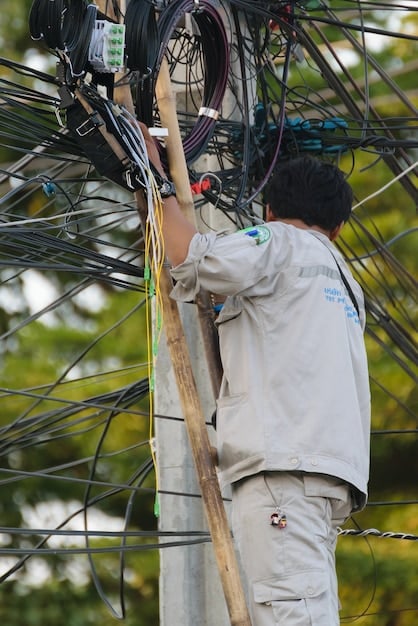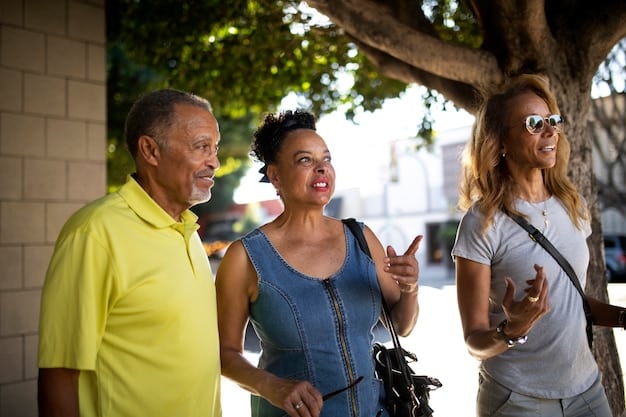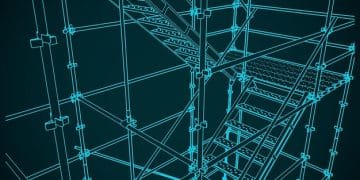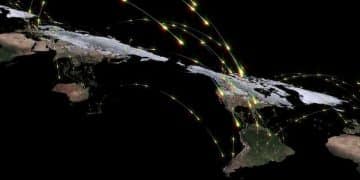US Digital Divide: Bridging Access to Technology for All

The US is actively working to bridge the digital divide by implementing various federal programs, fostering public-private partnerships, and investing in infrastructure to ensure equitable access to technology and the internet for all citizens.
In an increasingly interconnected world, access to technology and the internet is no longer a luxury but a fundamental necessity. The United States faces a significant challenge in ensuring that all its citizens, regardless of their socioeconomic status or geographic location, have equitable access to these critical resources. This article delves into how is the US addressing the digital divide and ensuring access to technology for all, exploring the multifaceted strategies, programs, and initiatives underway to achieve this ambitious goal.
Understanding the Digital Divide in the US
The digital divide in the United States is a complex issue, often characterized by disparities in internet access, device ownership, and digital literacy. While some segments of the population enjoy robust, affordable connectivity and state-of-the-art devices, others remain on the wrong side of this technological chasm.
This gap is not merely a matter of convenience; it impacts education, economic opportunity, healthcare access, and civic participation. Rural communities often struggle with limited infrastructure, while low-income urban areas face challenges related to affordability and digital literacy skills. The pandemic further illuminated and exacerbated these inequalities, highlighting the urgent need for comprehensive solutions.
Geographic and Socioeconomic Barriers
Geographic isolation often means limited or no access to broadband internet. Many rural areas lack the necessary infrastructure, making it economically unviable for private providers to extend services without significant government incentives. Meanwhile, in urban settings, even where infrastructure exists, the cost of internet service and devices can be prohibitive for low-income households.
- Rural Connectivity: Lack of infrastructure investment leads to slow or no internet.
- Urban Affordability: High costs of service and devices create barriers for low-income families.
- Socioeconomic Disparities: Income and education levels directly correlate with digital access.
- Digital Literacy: Even with access, many lack the skills to fully utilize technology.
Beyond physical access, the lack of digital skills is another significant barrier. Many individuals, particularly older adults and those with limited educational backgrounds, may not possess the necessary knowledge to navigate the internet, use digital tools effectively, or protect themselves online. This “usability divide” means that even with connectivity, the full benefits of technology remain out of reach.
Addressing these multifaceted barriers requires a holistic approach that combines infrastructure development, affordability programs, and comprehensive digital literacy initiatives. It’s about ensuring not just physical access, but also meaningful access that empowers individuals to thrive in the digital age.
Federal Initiatives and Funding for Broadband Expansion
The US government has recognized the urgency of closing the digital divide and has launched several ambitious federal initiatives backed by significant funding. These programs aim to expand broadband infrastructure, particularly in underserved areas, and make internet access more affordable for low-income households.
A cornerstone of these efforts is the Infrastructure Investment and Jobs Act (IIJA), signed into law in 2021. This bipartisan legislation allocates billions of dollars specifically for broadband infrastructure deployment, aiming to ensure that every American has access to reliable, high-speed internet.
Key Programs Under IIJA
The IIJA includes several key programs designed to tackle the digital divide head-on. The largest of these is the Broadband Equity, Access, and Deployment (BEAD) program, administered by the National Telecommunications and Information Administration (NTIA). BEAD provides over $42 billion to states, territories, and tribal governments to fund broadband deployment and adoption programs.
Another crucial component is the Affordable Connectivity Program (ACP), which offers a discount of up to $30 per month (and up to $75 for households on Tribal lands) on internet service for eligible low-income families. Complementing these are programs like the Middle Mile Broadband Infrastructure program, which invests in the critical backbone infrastructure needed to connect communities.
- BEAD Program: Over $42 billion for broadband infrastructure and adoption.
- Affordable Connectivity Program (ACP): Monthly subsidies for eligible households.
- Middle Mile Broadband Infrastructure: Funds for high-capacity fiber optic lines.
- Rural Digital Opportunity Fund (RDOF): FCC initiative to bring broadband to rural areas.
Beyond direct funding, these initiatives seek to streamline regulatory processes and foster collaboration between federal agencies, state governments, and private sector partners. The goal is not just to lay fiber, but to create a sustainable ecosystem where internet access is ubiquitous and affordable. The federal commitment represents a significant shift, acknowledging that universal broadband access is essential for national competitiveness and social equity.

Public-Private Partnerships and Local Initiatives
While federal funding provides a crucial foundation, the task of bridging the digital divide cannot be accomplished by government efforts alone. Public-private partnerships and innovative local initiatives play an indispensable role in ensuring that technology access reaches every corner of the nation.
These collaborations bring together the resources, expertise, and reach of government agencies, technology companies, non-profit organizations, and community groups. By combining forces, they can tailor solutions to specific local needs, often moving faster and more efficiently than large-scale federal programs might on their own.
Collaborative Models for Connectivity
Many internet service providers (ISPs) are partnering with local governments and community organizations to extend their networks into underserved areas. These partnerships often involve cost-sharing arrangements, expedited permitting, and community engagement to ensure that deployed infrastructure meets actual demand. For instance, some cities are developing municipal broadband networks, sometimes in collaboration with private partners, to offer affordable and reliable internet services directly to residents.
Non-profit organizations are also at the forefront of these efforts, working to secure grants, distribute devices, and provide digital literacy training. Their deep roots within communities enable them to identify specific needs and deliver targeted interventions, complementing the broader scope of federal and state programs.
- ISP Partnerships: Collaborating with local governments to expand network reach.
- Municipal Broadband: Cities investing in and managing their own internet infrastructure.
- Non-profit Programs: Device distribution, digital literacy training, and community outreach.
- Community Anchor Institutions: Libraries and schools offering free internet access points.
Additionally, public libraries, schools, and community centers serve as vital community anchor institutions, providing free Wi-Fi, computer access, and digital literacy resources. Many of these institutions have expanded their services, lending out hotspots and laptops, particularly during the pandemic, to support remote learning and work. These localized efforts are critical in creating an accessible and inclusive digital environment, demonstrating that solutions often emerge from the ground up, fueled by community needs and collaboration.
Addressing Digital Literacy and Skills Training
Providing internet access and devices is only half the battle; ensuring people possess the skills to effectively use technology is equally vital. The US is increasingly focusing on digital literacy and skills training as a core component of its strategy to close the digital divide, recognizing that meaningful access goes beyond mere connectivity.
Digital literacy encompasses the ability to find, evaluate, create, and communicate information using digital technologies. It also includes understanding online safety, privacy, and responsible digital citizenship. Without these skills, individuals may struggle to access online education, healthcare, employment opportunities, and government services, even if they have an internet connection.
Programs for Skill Enhancement
Various initiatives are underway across the nation to address this “usability gap.” Public libraries are often at the forefront, offering free computer classes, one-on-one technology assistance, and workshops on topics ranging from basic computer operations to advanced software applications. Many non-profit organizations specialize in digital inclusion, providing tailored training programs for specific demographics, such as older adults, immigrants, and low-income families.
Federal funding, often through programs like BEAD, also supports digital equity plans that include provisions for skill-building. States are developing their own strategies, often partnering with educational institutions, workforce development boards, and community organizations to deliver comprehensive training.
- Library Programs: Free computer classes and tech support.
- Non-profit Training: Tailored digital literacy programs for diverse groups.
- Workforce Development: Integrating digital skills into job training initiatives.
- K-12 Education: Ensuring digital literacy is a core part of the curriculum.
Furthermore, schools are integrating digital literacy into their curricula from an early age, preparing future generations for a digitally-driven world. For adults, workforce development programs increasingly include digital skills training to ensure job readiness in a rapidly evolving economy. These efforts underscore the understanding that true digital inclusion requires not just access to tools, but also the empowerment of individuals through knowledge and skills, enabling them to navigate and leverage the digital landscape confidently and safely.

Innovations and Future Outlook in Tech Access
The landscape of technology is constantly evolving, and so too must the strategies for ensuring universal access. The US is exploring and implementing various innovations, from new connectivity technologies to creative financing models, as it looks toward a future where the digital divide is a relic of the past.
Emerging technologies, such as 5G and low-Earth orbit (LEO) satellites, hold immense promise for expanding broadband access to remote and hard-to-reach areas where traditional fiber optic deployment might be prohibitively expensive. These innovations could provide high-speed, reliable internet without extensive ground infrastructure.
Leveraging New Technologies and Approaches
The expansion of 5G networks, particularly in urban and suburban areas, offers the potential for faster and more accessible wireless broadband. While not a direct substitute for fiber, 5G fixed wireless access can provide a viable alternative for many households. Satellite internet, with companies like Starlink leading the way, is rapidly improving, offering high-speed connectivity even in the most isolated rural regions, though cost remains a factor for some.
Beyond technology, there’s growing interest in innovative financing and ownership models. Community-owned networks, utility pole attachment reforms, and new public-private partnerships that share risk and reward are all being explored to accelerate deployment and ensure long-term affordability.
- 5G Expansion: Providing high-speed wireless broadband alternatives.
- Satellite Internet: Connecting remote areas with LEO satellite technology.
- Digital Inclusion Hubs: Centralized community spaces for access and training.
- Equitable Access Research: Studying and developing best practices for digital equity.
Looking ahead, the focus is not just on closing the initial gap, but on building resilient and adaptable digital ecosystems. This includes ongoing investment in infrastructure upgrades, continuous improvement in digital literacy programs to keep pace with technological change, and robust policies that safeguard affordability and privacy. The aim is to create a future where digital access is a given, not a struggle, and where technology truly serves as an equalizer for all Americans.
Challenges and Ongoing Efforts
Despite significant progress and substantial investment, the journey to eradicate the digital divide in the US is fraught with challenges. The path forward requires sustained effort, adaptability, and a willingness to confront persistent obstacles, including infrastructure complexities, socioeconomic hurdles, and the ever-evolving nature of technology itself.
One primary challenge remains the “last mile” problem—the difficulty and expense of connecting individual homes and businesses, especially in sparsely populated or geographically challenging terrains. Even with federal subsidies, the economics of serving these areas remain difficult for many providers.
Overcoming Persistent Hurdles
Affordability continues to be a major hurdle. While programs like ACP provide vital subsidies, many families still struggle to afford the monthly cost of internet service, let alone the devices required for meaningful use. Digital literacy also presents ongoing challenges, particularly for older populations and those with language barriers, requiring culturally sensitive and accessible training materials.
Maintaining political will and consistent funding is another critical factor. Broadband deployment is a long-term endeavor, and success depends on continued bipartisan support and sustained investment over many years. Furthermore, the rapid pace of technological change means that “adequate” access is a moving target, requiring continuous upgrades and adaptation.
- Last-Mile Connectivity: High costs of connecting individual homes in remote areas.
- Sustainable Affordability: Ensuring long-term internet and device affordability.
- Digital Inclusion Gaps: Reaching marginalized groups with tailored support.
- Evolving Technology: Keeping pace with new standards and connectivity demands.
Addressing these challenges requires a multi-pronged strategy that combines robust infrastructure investment, innovative financial models that ensure affordability, comprehensive and accessible digital literacy programs, and strong policy frameworks that promote competition and consumer protection. It also demands ongoing data collection and analysis to precisely identify remaining gaps and measure the effectiveness of various interventions. The commitment to a digitally inclusive America remains strong, but the work is far from over.
| Key Aspect | Brief Description |
|---|---|
| 🌐 Federal Funding Initiatives | Billions invested via programs like BEAD (Broadband Equity, Access, and Deployment) to expand infrastructure nationwide. |
| 🤝 Public-Private Partnerships | Collaborations between government, ISPs, and non-profits to deploy broadband and offer affordable services. |
| 📚 Digital Literacy Programs | Libraries and community centers provide training to ensure individuals can effectively use technology. |
| 💡 Technological Innovations | Exploring 5G and satellite internet (LEO) for widespread, high-speed connectivity in challenging areas. |
Frequently Asked Questions
▼
The digital divide refers to the gap between those who have ready access to computers and the internet, and those who do not. This disparity can be due to socioeconomic status, geographic location, age, or disability, affecting access to education, employment, and essential services.
▼
The ACP is a federal program that provides a discount of up to $30 per month (or $75 on qualifying Tribal lands) on internet service for eligible low-income households. It aims to make broadband more affordable and accessible, helping families stay connected and participate in the digital economy.
▼
The IIJA allocates significant funding, notably through the BEAD program, to expand broadband infrastructure across the U.S., especially in underserved rural and urban areas. It also supports digital equity and inclusion initiatives, ensuring communities have the resources for technology adoption and skill-building.
▼
Digital literacy goes beyond mere internet access; it’s the ability to use technology effectively, safely, and critically. Without these skills, individuals cannot fully leverage online resources for education, jobs, healthcare, or civic engagement, making skill-building programs crucial for true digital inclusion.
▼
Public libraries are vital community hubs for digital inclusion, providing free internet access, computer labs, and digital literacy training. Many also lend out devices like Wi-Fi hotspots and laptops, serving as critical access points and resource centers for underserved populations.
Conclusion
The United States is undertaking a comprehensive and multi-faceted effort to bridge the digital divide and ensure that all its citizens have equitable access to technology and the internet. From massive federal investments in infrastructure through programs like BEAD, to vital public-private partnerships, and dedicated initiatives focused on digital literacy and skill-building, the commitment is clear. While significant challenges remain, including the complexities of last-mile connectivity and ensuring long-term affordability, the collective momentum from government, industry, and community organizations is driving meaningful progress. The vision of a digitally connected America, where technology serves as a tool for opportunity and inclusion for everyone, is steadily becoming a reality.





